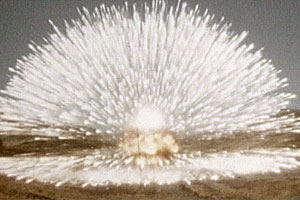We were asked to surrender all of our communications devices before entering the High Explosives Applications Facility at Lawrence Livermore National Laboratory in Livermore, CA. After handing over our cell phones, checking our IDs and getting our badges, we were led through a labyrinth of Cold War-era concrete hallways where there is a definite atmosphere of secrecy and caution.
It’s true that the majority of the work done there is in support of Department of Defense and Department of Energy programs. But contrary to what one might imagine, the scientists there are work that goes on there isn't ALL about figuring out how to protect the U.S. from Communism. The scientists here are chemists, physicists and engineers who are delving into everything from warhead electrical systems to enhanced mammography.

We’re led into the "firing chamber" to meet our explosives guy, Jon Maienschein, who has promised to blow something up for us. I’m excited. It’s hard to make a bad TV segment when an explosion is involved. If you watch television, you will see that many shows live and die by that rule. Maienshein is surprisingly mild-mannered for a guy who blows things up for a living. After interviewing him for about 30 minutes on camera, we finally had a very basic understanding of what’s happening during a detonation.
There are several different kinds of explosions: chemical, natural, mechanical and nuclear, electrical, astronomical, etc. The most common "artificial" explosives are chemical usually involving a violent, rapid oxidation reaction. The fine folks at LLNL demonstrated just such and explosion for us then gave us the super-cool, ultra-slow-motion footage that they shoot in order to study what actually goes on inside an explosion.
We see or hear about explosions practically every day on TV, the movies and in the news, most people have no idea what an explosion really is. What’s happening on the chemical and molecular level? And how do the people who know about explosives actually study explosions? And why is it necessary to understand this stuff? The whole thing is surprisingly complex.